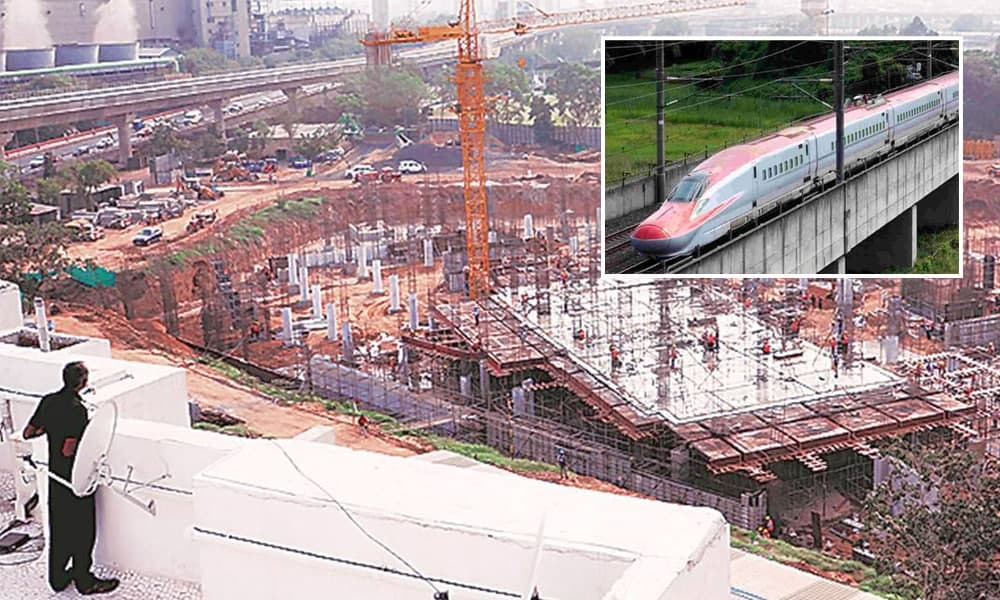
Image Credits: Indian Express
'Build Substitute For Chinese Tech For Bullet Train Self-Reliance': Govt Tells Industries
India, 2 Dec 2020 7:21 AM GMT
Editor : Prateek Gautam |
A free soul who believes that journalism, apart from politics, should stand for social cause and the environment.
Creatives : Abhishek M
" An engineer by profession, Abhishek is the creative producer of the team, graphic designing is his passion and travelling his get away. In more ways than one, he makes the content visually appealing."
Big Chinese machines like the Mega Carrier and launcher machines like the Transporter, Gantry and Full Spam Launcher machines are very common in large scale connectivity projects.
As India moves ahead on its path of 'Atmanirbhar Bharat' and the trade with China has been affected by the border tension in Eastern Ladakh, Indian industries have been asked to come up with an alternative to high-tech machines needed to conduct viaducts (elevated structures) during construction, which is currently being made only in China.
Big Chinese machines like the Mega Carrier and launcher machines like the Transporter, Gantry and Full Spam Launcher machines are very common in large scale connectivity projects.
A vehicle carrying a full girder travels on an already launched girder to place the next girder. Under this kind of technology, the speed is almost seven times more than the one used in India. While in India, one-and-a-half girders are placed in a week, the Chinese machines enable two girders a day.
Prime Minister Narendra Modi's dream project - bullet train - will turn out to be a costly affair as each machine cost around ₹70-80 crore and the bullet train project will need up to 30 such machines, Managing Director of the National High-Speed Rail Corporation (NHSRL), Achal Khare said.
"If we are to build 237 km in four years, there is no other way except to use this technique. But these carrier-and-launcher machines are manufactured in China. So this is one of the challenges which we have posed to the industry, including L&T (which is building 325 km of a high-speed viaduct in Gujarat) and the academicians, that why can't we develop them rather than importing them from China?" Khare told a meeting of the industry body.
The Indian Industry possesses no experience of building high-speed rail systems, reported The Indian Express.
"I guess people here never needed to apply their minds to make them because they were available cheap in China. Now we are telling people to try and design them, let's be self-reliant. It's not like Indian engineers cannot make it," said Khare.
He also talked about the current situation and how the government is emphasising on 'Atmanirbhar Bharat', how it was unlikely, and that anyone would have get these machines from China.
Khare accepted the fact that these machines are "no joke" and exclaimed that Japan who is even helping India in the bullet train project has not been able to design such machines, "They are vehicles capable of carrying loads of 1000 tonnes-plus. Currently, girders are carried by road in little segments," he said.
Similar to Japan's high-speed Shinkansen system, the National High Speed Rail Corporation Limited (NHSRCL) has asked the Ahmedabad Textile Research Institute to work on developing an upholstery.
"They say that even if you pour petrol on the upholstery and set it on fire, it will not propagate. We cannot be dependent on Japan forever for this," Khare said.
Several IITs are in the process of making a simulation software for electrical systems on the order of the NHSRCL, these systems are currently the sole domain of foreign consultants engaged in railway and such other projects.
The industry and engineering institutes have also been asked to study ballastless track which can replicate the Shinkansen technology.
To replicate the Shinkansen system, NHSRCL is planning to hire management professionals and send them on secondment to JR East, which runs the Shinkansen so that they learn about the system and bring that culture in India.
In a recent development, India will carry out 75% of the construction for the project through Indian firms, in such projects around ₹80,000-₹90,000 crores worth of contracts are mostly in civil construction and even track laying would go to Indian companies.
The project without normal inflation factored in from 2015 is estimated at ₹1.08 lakh crore.
The Indian contractors have been told by the NHSRCL to ensure that their staff, starting from rail-welding technicians to engineers, motor car operators and supervisors, get trained and certified by a reputed Japanese agency.
The training sessions can last from a few days to 125 days and the cost of the training has to be borne by the contractors.
For the deadline of December 2023, the Railway insists that the project is still on time.
Also Read: Students From IIT-M Design Handy Device For Typing In Braille
 All section
All section














